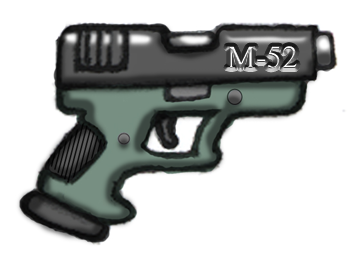 |
USSN SMALL ARMS & EQUIPMENT(Version 1- Last Modified: Sunday, July 03rd 2011)RPG Stats by Kodai Okuda (primeadministrator@nexusarcana.com) |
|
 |
USSN SMALL ARMS & EQUIPMENT(Version 1- Last Modified: Sunday, July 03rd 2011)RPG Stats by Kodai Okuda (primeadministrator@nexusarcana.com) |
|
Small arms development after the Asian Pacific Conflict of the late 2040s centered on the construction of medium caliber, lightweight, infantry weapons, and large caliber, heavy, cyborg weaponry.

This was the basic infantry battlerifle of the armed forces of the USNA. It was a semiautomatic only weapon designed to provide a high level of accuracy combined with durability. It was chambered for the 7mm x 42mm intermediate cartridge and used a thirty-round, triple-stack, box magazine. It had a multispectral optical sight and emergency iron sites. The weapon was accurate out to 500 yards, had a side-folding stock for vehicle travel, and green impact-resistant plastic furniture. This weapon was very common throughout the USSN after the Great War and was in use by the armies and militia of the EFR during the first few years of the 1st Interplanetary War.

The M-52 was the standard infantry "body" pistol sidearm used by both militia and regular troops of the USNA during the Great War period. It was later sized up to a larger model for pilots, naval crews, and SpaceNavy personnel. The larger model was called the M-54. Both pistols used the 7mm x 21mm AMP (Autoloading Military Pistol) cartridge. The M-52 had a ten-round, triple-stack magazine, while the M-54 used a twenty-round, triple-stack magazine. Grip sizes of both pistols were somewhat on the thick side and something of an annoyance to the personnel who used either of the weapons. However, both pistols were very reliable, even under adverse conditions. This and their exceptional accuracy led to their widespread use and popularity. Many of these pistols were still in service with the EFF during the 1st Interplanetary War.

Larger version of the M-52. See description above.

The ZGR-61 was designed by the USSN after the Great War was over and their struggle with the UNSC had become one of survival. The ZGR-61 took advantage of the low gravity environment of most spacecraft, spacestations, and the planetoids within the inner sphere of the Sol System. This allowed the use of the large 12mm x 120mm M999 caseless cartridge. This round was intended for use against armored personnel and cyborgs. The ZGR-61 used a twenty-round, dual-stack magazine, which added to the weapon's considerable weight. The rifle used a recoil-compensation device that pulled the shooter forward via jets of propellant gas when the weapon discharged. This gave the shooter some measure of stability in zero and low gravity environments. A recoilless foregrip-mounted plasma grenade launcher was standard with the ZGR-61. The weapon was very popular with cyborgs and spacemarine infantry. These weapons continued in service with the USSN and EFF during the initial years of the 1st Interplanetary War. This was one of the favorite weapons of legendary spacemarine Kabuto Tokugawa of the Sledgehammers.

Essentially a handheld recoilless rifle, the PG-62 was the most devastating weapon of the post-Great War era of the 2060s. This weapon was designed to give a single soldier the ability to destroy UNSC hovertanks, like the Type-55. It was also useful in burning out the interiors of UNSC assault shuttles, and blasting through most airlocks and bulkheads of its day as well as repelling boarding parties. The weapon used a twenty-round box magazine and had a multispectral optical sight. Emergency iron sights were also mounted on the weapon. By 2068 AD, nearly every weapons locker of USSN Kentucky class assault shuttles had at least one of these weapons in it, complete with extra magazines.

The HCA-01 was old when the USNA began mass producing it in 2051 AD. It was designed by the United States of America for their marine and army forces during the 2030s, but never produced. The HCA-01 was generally a good design which incorporated a multispectral sensor helmet, NBC protection (nuclear, biological, chemical) and ballistic resistance. The armor was designed for both planetary and space operations and could withstand all manner of environments. The HCA-01 could act as an Extra-Vehicular Activity suit in space and on airless planetoids and moons throughout the inner Solar System. This armor was used throughout the Great War and by the USSN during the 2060s. It was the most common type of security and police armor of the 2070s and early 2080s
SPECIAL FEATURES: Full EVA protection, 4 hours oxygen supply, can resist up to 20 rads per minute of radiation exposure, resist heat of 2000°F or less, has magnetic boots, can resist cold of down to -200°F, helmet has 2 way radio, range is 50 miles, full light spectrum sensors, acoustic, and heat sensors, plus a targeting sight adds +1 to hit.

Nearly as old a design as the HCA-01, the standard Extra-Vehicular Activity suit of the United States Space Navy was the EVA-01. This suit was designed during the early 2040s as a replacement for the bulkier suits of the 2020s-30s used by NASA. It was a bare bones basic unit intended to be used for limited durations of up to six hours outside of a vehicle or spacecraft. The suit was one of the first to be equipped with a built-in CO2 thruster pack. This thruster pack had two vector control nozzles and could reach a maximum speed of 30 mph in space or a zero-g environment. These suits were used throughout the Great War, the 2060s, and the first years of the 1st Interplanetary War.
SPECIAL FEATURES: Full EVA protection, 6 hour oxygen supply, resist heat up to 1000°F or less, and resist cold of -275°F or higher, magnetic boots, helmet has a 2 way radio with a 30 mile range, heads up display with heat, acoustic, and full light spectrum sensors. Back pack has a built in rocket thruster with 4 hours of fuel and a speed of 30 mph in space only. Suit can resist up to 10 rads of radiation per minute.